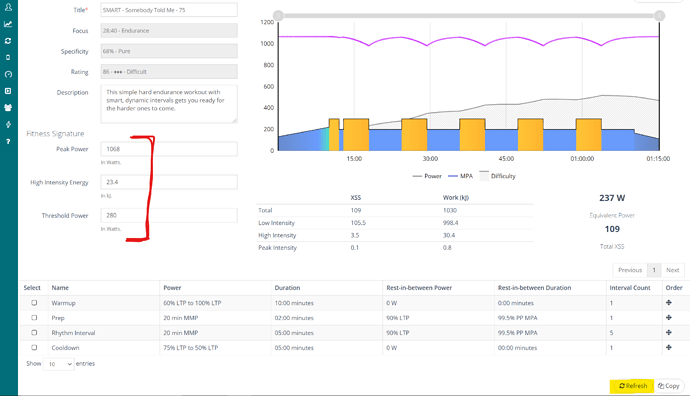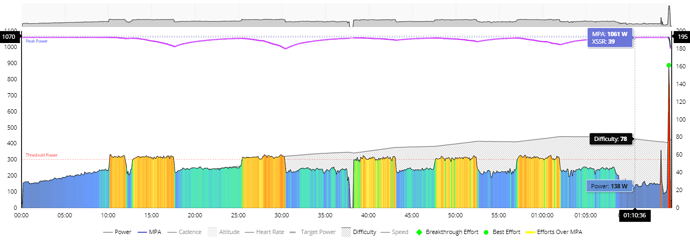Did my first SMART workout recently, I found the rest intervals behaved a bit oddly for me. For the power intervals, increasing power over the target value makes them, as intended, shorter. However for the rest periods, going above the target power makes them longer (because of the assumed slower MPA recovery I think), even if power is below TP. Crucially it means the less you do in the rest periods the faster they go - that doesn’t seem right to me? Shouldn’t there be some incentive to keep pedalling?
Hi Julie. Yes they are a bit counter-intuitive but the way they are defined, the workout wants you to get to a certain recovery point before the next interval starts. If you go too hard, well then it’s going to take you longer before you’re recovered enough for the next high-intensity effort. The other benefit to this is that if you decide you don’t want to just stop pedaling, you’ll need to be ready for the next high-intensity interval sooner. There is no benefit to resting more than needed.
Thanks for the explaining that! I guess it makes sense that if you feel recovered quickly the next intervall starts sooner. It is just as you said, a bit counter-intuitive in that you can’t speed up the workout by working harder. Working harder will make it longer, so you’re working even more…
Hi Armando,
I completed a workout today “somebody told me 90” i completed 90mins (at least that what the workout timer told me) but when it uploaded from the remote player on the garmin, it’s saying the workout was only 74mins. It seems the last two rest intervals were shorter. Has this something to do with recovering quicker or holding lower target power? Is this similar to this topic is this what Smart training does. I feel i’ve been punished here i wanted to hit my XSS and came up short.
Thanks Gavin.
All of the SMART workouts are variable by design but normally the end result will be close to predicted XSS value.
If you consistently ride work intervals harder than watts defined and recovery intervals easier than defined, the interval times can be shortened by as much 50%.
The player will display defined times for each interval and total time, but if you watch closely the speed as which you complete each interval won’t match real time unless you are a well-oiled machine able to maintain exact targets.
The easiest way to see this is during a recovery interval. Stop pedaling and suddenly the countdown timer accelerates. A 2 minute recovery could shorten to 1 minute in real time.
Trainer control may also be a factor depending on transition response times.
How far off was the predicted workout XSS from your completed workout?
Keep in mind the daily XSS number isn’t a target you have to hit in order to benefit.
As long as the pacer needle hovers in the 11am-1pm range you’re doing fine and your TL progression is on target. 
Reference: Introducing Smart Workouts – Xert (baronbiosys.com)
We’ve discussed extensive already how the intervals will change in time according to how you’re performing the workout, but I’d also like to highlight another important aspect… the starting duration of many SMART duration intervals will also vary, depending on the signature. You can test this by opening a workout with smart duration (like somebody told me) and changing the fitness signature.
We try to identify the approximate duration as being 60/75/90 etc., but the exact duration will always depend on your signature + the execution. Hope this makes sense!
The 90min workout was 130XSS but my 74min workout was 107XSS
I don’t have a smart trainer, it’s a fluid trainer. I towel off a bit during recovery’s which kinda hinders my power. It’s gonna take a while to get my head around xert I think
Thanks for the reply and link.
Gav
Thanks for the reply Scott I’ll be honest I don’t understand this. What do I change in the fitness signature to see a change in the workout? what am I looking for, time duration? Can you give a quick example or a link.
Thanks Gavin
On the lefthand side, your current fitness signature is displayed in the workout player. You can, however, directly modify the signature parameters and then click REFRESH on the bottom right-hand corner of the screen to see what the workout would look like with the new Fitness Signature. By tweaking the fitness signature, you’ll notice that the total duration of the workout will change (at least for most of the workouts that use Target MPA duration intervals).
Cheers,
Scott
Hi Scott,
Thanks for the reply again. Opening the same workout and changing the parameters on the fitness signature seem to change the interval intensity not time duration. Also opening up the same past activity and manipulating the signature in advance MPA does the same thing and skews the XSS up or down depending. While this is all new to me now. I’m wondering in what context do Xert users use this feature for?
Back to my original question… there is at least 3mins gone from each of the last two recoveries which makes sense to me (power was down recovered quicker didn’t need another 3min but lost out on intensity and dropped strain score correct?). I’m not sure where I lost the rest of the time 10mins as all other durations seem to be correct.
Does the high intensity intervals time slow down to get the correct right strain for the interval?
Thanks again I know this seems tedious but it will better help me get my head around what’s going on here.
Gavin
That likely explains the discrepancy. With a smart trainer it’s easy to hit targets and maintain them within a couple watts. On a fluid trainer the wattage will fluctuate quite a bit as you gear up/down and change cadence to hit targets and maintain them. Easing off on recovery intervals would shorten them quite a bit. On a smart trainer you would have to stop pedaling for the same effect since the trainer is constantly changing resistance to maintain target watts while you pedal.
Enable target watts on your activity chart to see the over/under performance compared to targets, but I believe you met #2 below.
A Smart Workout has three key points of differentiation:
- Smart Workouts use advanced mathematical modeling to know precisely where you will be from a fatigue standpoint, i.e. MPA, at every point in a workout;
- New interval definitions are used to pinpoint specific power and fatigue levels to achieve strain and focus targets according to the desired training loads;
- Workout players also use advanced mathematical models, in real-time, to adjust either interval power or duration to assist the athlete in meeting the goals of the workout.
I don’t know how deep you want to delve into the science behind SMART workouts but this article explains how to create them.
Advanced Workout Design using SMART Intervals – Xert (baronbiosys.com)
I’ll make a short demo to show what I mean. Let’s take two athletes with same Threshold Power, but different HIE/PP’s and have them perform the same set of intervals, using Target MPA as the duration.
Athlete 1: 1200 PP | 26.0 HIE | 250 TP
Athlete 2: 800 PP | 16.0 HIE | 250 TP
Mini-workout is 5 reps of 1 min at 5 MMP and recovery at 50 XSSR until 99.5% Target MPA Reserve…
For athlete 1: Aside from the differences in target power for the intervals, the 5 reps would take a combined total of 26:18 to complete the entire set of 5 intervals (assuming perfect execution of the workout)
For athlete 2: The same 5 reps of the workout would be completed in 19:11 (assuming perfect execution)
So, this goes to show that any of the SMART workouts with variable duration (Target MPA duration) intervals will not only adjust in real time, based on your execution as discussed above, but that the starting duration of the workout will vary from individual to individual. When workouts are created & tested, many are indicated by an approximate time, which can vary across individuals, or adjust as the target power is above/below target. Hope this makes sense!
Thanks for the feedback ridgerider this is very informative, and I’m slowly comin around to how these workouts are being processed by Xert. The points you’ve shown are very clever by the system. In the real world though not everything will run smoothly during a workout example would be…
- access sweat toweling off loosing power in the process
- feeling uncomfortable in static position after an hour thus jostling position around can causing power drops.
- interruptions during workouts may have to stop.
I guess there can be a variety of reason why power might drop during a workout and it will have nothing to to with fatigue. The Xert software will interpreted it as such but will it effect the over all out come? I would think not. As you say as long as the workout is complete and the XATA needle is where it should be.
Thanks Gavin.



